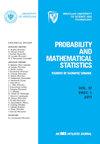一维均匀数据中自反和共享近邻对的数目
IF 0.4
4区 数学
Q4 STATISTICS & PROBABILITY
引用次数: 3
摘要
对于R中的点的随机样本,我们考虑成员是彼此最近邻NN的对的数量和共享一个共同NN的对的数量。第一种类型的对称为自反神经网络,而后一种类型的对称为共享神经网络。在本文中,我们考虑大小为n的随机样本来自区间上的均匀分布的情况。我们用Rn和Qn分别表示样本中自反NN对的个数和共享NN对的个数。我们导出了Rn和Qn的期望值和方差的精确形式,并导出了Rn的递推关系,该递推关系也可用于计算Rn的精确概率质量函数pmf。我们的方法是一种寻找Rn的pmf的新方法,与文献中的结果一致。我们还给出了n趋于无穷时Rn和Qn的SLLN和CLT结果。本文章由计算机程序翻译,如有差异,请以英文原文为准。
On the number of reflexive and shared nearest neighbor pairs in one-dimensional uniform data
For a random sample of points in R, we consider the number of pairs whose members are nearest neighbors NNs to each other and the number of pairs sharing a common NN. The pairs of the first type are called reflexive NNs, whereas the pairs of the latter type are called shared NNs. In this article, we consider the case where the random sample of size n is from the uniform distribution on an interval. We denote the number of reflexive NN pairs and the number of shared NN pairs in the sample by Rn and Qn, respectively. We derive the exact forms of the expected value and the variance for both Rn and Qn, and derive a recurrence relation for Rn which may also be used to compute the exact probability mass function pmf of Rn. Our approach is a novel method for finding the pmf of Rn and agrees with the results in the literature. We also present SLLN and CLT results for both Rn and Qn as n goes to infinity.
求助全文
通过发布文献求助,成功后即可免费获取论文全文。
去求助
来源期刊

Probability and Mathematical Statistics-Poland
STATISTICS & PROBABILITY-
CiteScore
0.70
自引率
0.00%
发文量
0
审稿时长
>12 weeks
期刊介绍:
PROBABILITY AND MATHEMATICAL STATISTICS is published by the Kazimierz Urbanik Center for Probability and Mathematical Statistics, and is sponsored jointly by the Faculty of Mathematics and Computer Science of University of Wrocław and the Faculty of Pure and Applied Mathematics of Wrocław University of Science and Technology. The purpose of the journal is to publish original contributions to the theory of probability and mathematical statistics.
 求助内容:
求助内容: 应助结果提醒方式:
应助结果提醒方式:


